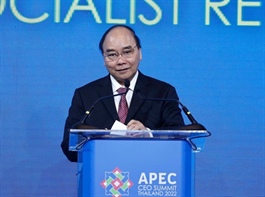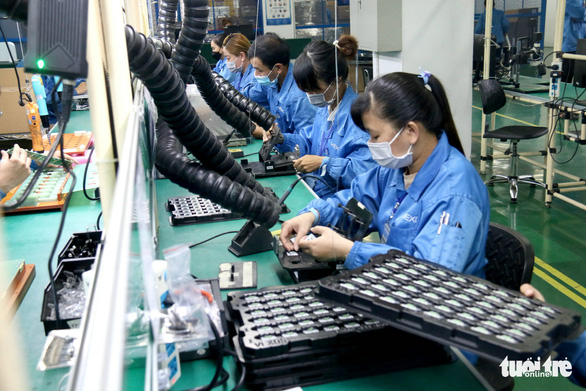GDP growth target at 6.5 per cent in 2023 proves feasible
GDP growth target at 6.5 per cent in 2023 proves feasible
Phi Huong Nga, deputy general director of the Department of Industrial and Construction Statistics under the General Statistics Office, explains to VIR's Manh Bon why the economic growth target set by the National Assembly at 6.5 per cent in 2023 is feasible, yet not easy to reach.
At the end of the third quarter of 2022, the General Statistics Office (GSO) forecasts that GDP will grow by 7.5-8.0 per cent in this year. What do you think about this forecast?
We forecast two economic growth scenarios in 2022 based on growth in the first nine months of the year and difficulties our country may face in the rest of the year.
The first scenario is GDP growth in the fourth quarter of at least 4.14 per cent, leading to GDP growth of 7.5 per cent for the whole year. Actually, 4.14 per cent is one of the lowest quarterly growth rates lately, even lower than 5.22 per cent of the fourth quarter last year and 4.61 per cent of the fourth quarter of 2020, which is the period that Vietnam’s economy faced unprecedented difficulties.
The second scenario is GDP growth for the entire year of 8 per cent, if GDP of the fourth quarter 2022 grow at least 5.9 per cent. Despite many difficulties in the last quarter, Vietnam’s economy is bouncing back strongly, especially the service industries such as wholesale and retail; accommodation; food and beverage; transportation and warehousing; and so on.
Therefore, GDP growth for the full year, if not affected by major fluctuations, is likely to reach 8 per cent or even higher. It is considered as positive signs, but also putting pressure on the 6.5 per cent growth target next year.
Do you think that the GSO's forecast of GDP growth rate in 2022 of 8 per cent, or even higher, is too optimistic?
Based on the results of the past 10 months, GDP growth of at least 8 per cent is not an over-optimistic forecast.
As workers' income has continuously increased amid falling unemployment, the consumer demand is expected to go up steadily, providing a driving force to boost GDP in the fourth quarter of 2022 and next year.
Notably, Vietnam’s index of industrial production (IIP) returned to pre-pandemic level, growing by 9 per cent in the first 10 months of 2022 compared to the same period last year. In particular, the processing and manufacturing industry increased by 9.6 per cent, of which many key industries reached impressive growth such as beer production up 34.7 per cent; processed seafood up more than 19 per cent; phone components up 16.5 per cent; automobiles up 16.4 per cent; bar steel, angle steel up 15.2 per cent.
In terms of domestic consumption, the total retail sales of consumer goods and services in the first 10 months of 2022 increased by 20.2 per cent on-year.
Total domestic demand in the first 10 months increased by nearly 14 per cent compared to the same pre-pandemic period in 2019. However, total retail sales of consumer goods and services in the first 10 months of 2022 is estimated to reach only 83 per cent of the total achievable retail level.
As workers' income has continuously increased amid falling unemployment, the consumer demand is expected to go up steadily, providing a driving force to boost GDP in the fourth quarter of 2022 and next year.
Additionally, in the first 10 months of the year, trading value touched $616.24 billion, showing 14 per cent jump on-year, inducing Vietnam’s trade surplus at $9.4 billion. This result is very impressive because the total import-export value of goods in the first 10 months of 2021 just approximated $540.3 billion.
Does the performance of enterprises reflect the economic rebound?
In the first 10 months of 2022, the total investment of domestic businesses surpassed 31 per cent, including a total registered capital of nearly $59.96 billion from 125,800 newly established enterprises and the additional capital of $121.48 billion from 42,600 enterprises raising capital.
Thanks to positive business and production performance, in the first 10 months this year, 52,700 enterprises resumed operation, up 49 per cent compared to the same period last year.
So, in the first 10 months of 2022, the total number of newly established enterprises and enterprises resuming business approximated 178,500, an increase of 38.3 per cent. This result is deemed a driving force not only to promote GDP growth in the fourth quarter of 2022 but in the following years, especially the GDP growth target of 6.5 per cent in 2023 which has been approved by the National Assembly.
In early November 2022, the US Federal Reserve raised the basic rate by 75 basis points to 3.75-4 per cent, marking the sixth consecutive rate hike since March this year. Accordingly, do you think the State Bank of Vietnam (SBV) will continue to raise interest rate?
The SBV’s increase in key interest rates twice, with fiscal and other policies, aims to ensure the security of monetary, credit, finance, public debt, and inflation control. The consumer price index (CPI) only increased by 2.89 per cent in the first 10 months this year, thanks partly to tight monetary policy.
Tightening the monetary policy to control inflation by interest rate tools is a double-edged sword because withdrawing a large amount of money from circulation will make access to capital harder, raising the cost of borrowing and investment is gradually limited. This can also affect the resilience of the economy. Besides, rising interest rates also indirectly temper consumer demand, thereby negatively impacting domestic production.
As the CPI in the first 10 months of this year only inched up 2.89 per cent, I think the central bank would keep key interest rates unchanged from now until the end of the year, although the Fed and many central banks around the world still consider raising interest rates as the main tool to reduce inflation.





















